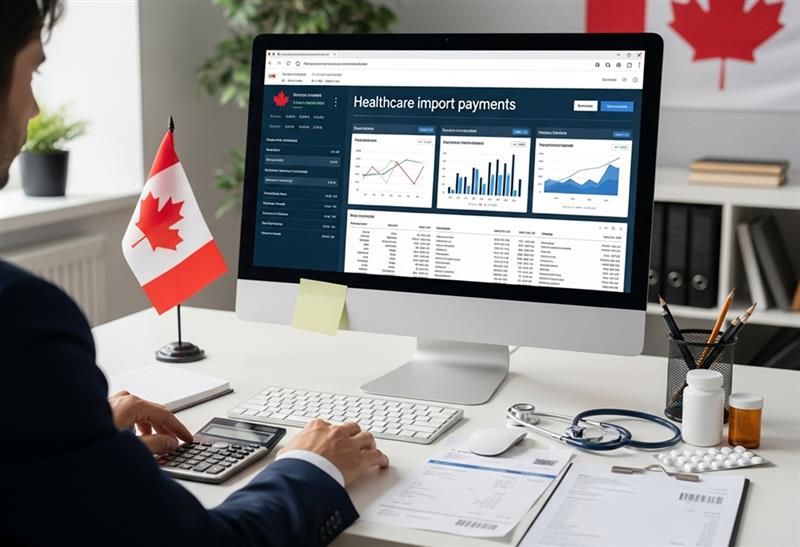How Canadian Businesses can Cut Healthcare Import Costs
Canadian healthcare companies rely on international suppliers for medicines, vaccines, and equipment. Canada’s pharmaceutical imports are mainly sourced from the US, Europe, India, and China, requiring timely cross-border healthcare payments. To avoid delays and extra costs, businesses often use specialist providers like MTFX to pay medical suppliers overseas with better exchange rates, faster transfers, and full compliance support.
Canada depends on global supply chains for essential medicines, vaccines, and advanced medical equipment. From life-saving drugs to diagnostic imaging systems, healthcare imports ensure hospitals and pharmacies remain stocked.
Yet managing cross-border healthcare payments is often complex. Businesses face high banking fees, currency volatility, and strict compliance requirements, all while ensuring suppliers abroad are paid on time. Efficient solutions are critical to keeping supply chains moving and patients protected. Read further to learn what problems you can face during global business money transfers and how you can solve it.
The challenges Canadian businesses face when paying for healthcare and pharma imports
Canadian healthcare providers, distributors, and pharmaceutical companies depend on seamless international payments to keep supply chains moving. Yet when a Canadian business pays for overseas healthcare services or settles invoices with global suppliers, the process is often slowed down or made more expensive by banking limitations.
High banking fees and poor exchange rates
Traditional banks typically apply hidden markups of 2–5% on foreign exchange, plus additional wire transfer charges. For businesses importing high-value medical equipment such as MRI scanners, ventilators, or diagnostic imaging systems from the United States and Europe, these costs quickly add up. Even a small percentage difference on a multimillion-dollar order of diagnostic machines can significantly erode margins. Use the MTFX live exchange rate widget below to see the real-time market rate, compare it with typical bank pricing, and estimate your savings before you pay.
Payment delays
Time is critical when importing medicines or medical devices. For example, delays in wire transfers can hold up shipments of essential items like surgical instruments from Germany, infusion pumps from the United States, or patient monitoring equipment from Japan. In pharmaceuticals, a late payment might stall deliveries of critical drugs such as insulin, antibiotics, or vaccines, disrupting hospital and pharmacy supplies across Canada.
Complex compliance and regulations
The healthcare and pharmaceutical sector is one of the most tightly regulated in global trade. Canadian businesses making international pharma supplier payments must comply not only with FINTRAC requirements at home but also with regulatory frameworks in the exporting countries. Payments related to controlled substances, biologics, or specialty oncology drugs often require additional documentation and approval. A missing certificate of origin or regulatory clearance can delay both the payment and the release of goods at customs.
Currency risk
Pharmaceutical imports are frequently invoiced in major currencies such as USD, EUR, or JPY. Exchange rate volatility has a direct impact on procurement costs. For instance, a Canadian distributor importing vaccines from Belgium or branded medicines from the United States could see costs rise sharply if the CAD weakens against the euro or the dollar between the time of invoicing and payment. Even a 2–3% shift in the CAD/USD exchange rate can translate into tens of thousands of dollars in additional expense on a bulk shipment of essential medicines.

Why Canadian healthcare and pharmaceutical companies need better payment solutions
The global supply chain behind Canada’s healthcare system has grown increasingly complex. As Canada imports pharmaceuticals and medical devices from many parts of the world, payment systems must evolve to match that complexity with speed, transparency, and flexibility.
Import reliance: the scale of what Canada brings in
Canadian healthcare providers rely heavily on international suppliers for everything from essential medicines to advanced diagnostic equipment. This high level of dependency increases the need for reliable cross-border transactions that ensure goods move without financial bottlenecks.
Why speed and reliability matter
Delays in payments can cascade through the supply chain. Hospitals depend on just-in-time deliveries of reagents, imaging parts such as CT scanner components and MRI coils, and specialty medicines like oncology drugs and biologics. When a Canadian distributor or hospital makes cross-border healthcare payments late, the supplier may hold the order, customs may delay clearance, or logistical windows may be missed.
In areas like pharmaceutical cold supply chains (vaccines and biologics) or diagnostics (PCR test kits and immunoassay reagents), a delay of even 24–48 hours can compromise product shelf-life or disrupt delivery timelines.
Scaling costs beyond markups
The issue is not only higher fees from traditional providers but also the inefficiency of outdated systems.
- Managing dozens of supplier relationships across multiple currencies becomes cumbersome without modern tools for real-time exchange rates or batch processing.
- Manual reconciliation across time zones and multiple intermediaries introduces errors and slows down operations.
- Traditional methods do not scale effectively during demand surges, such as public health emergencies, when speed is most critical.
Accountability and transparency in healthcare finance
Healthcare and pharma are subject to intense scrutiny from regulators, procurement bodies, and the public. Every dollar spent must often be tracked and justified.
- When Canadian companies pay overseas suppliers for medical devices or pharmaceuticals, unclear fee structures or hidden spreads complicate internal audits.
- In regulated pharmaceutical industries, finance teams need assurance that payments are accurate, timely, and fully traceable.
- Transparent payment records are essential for building trust and ensuring the integrity of international procurement processes.
Canadian businesses paying suppliers abroad: What you need to know
When it comes to maintaining steady access to essential medicines and equipment, Canadian businesses must navigate complex international payment corridors. As Canada imports pharmaceuticals and medical devices from leading markets, ensuring funds move quickly, securely, and cost-effectively is just as important as the logistics of shipping.
Key corridors for healthcare and pharma imports
The largest share of healthcare imports Canada relies on come from the United States and Europe. US suppliers provide insulin, ventilators, and imaging equipment, while Europe is a key source for vaccines, oncology treatments, and high-end diagnostic machinery. India and China also play an important role, supplying bulk generic medicines, active pharmaceutical ingredients (APIs), and surgical equipment. Each of these regions requires different currencies and payment practices, making it essential for Canadian companies to work with providers that can handle diverse corridors efficiently. Hence, you need a provider that offer CAD to USD, JPY, GBP, and other transfers.
Typical payment structures
Businesses that pay medical suppliers overseas often operate with two types of payment structures:
- Large one-time payments for bulk orders – for example, when a distributor imports a shipment of branded oncology drugs or advanced MRI coils.
- Recurring payments for ongoing supply – such as monthly purchases of antibiotics, disposable medical devices, or reagents needed for laboratory testing.
Having the right payment solution in place helps businesses manage both models without delays or excessive fees.
Ensuring cost-effective international transfers
Exchange rates play a critical role when paying overseas suppliers. Large imports from the US are usually billed in USD, while European partners require EUR, and Indian suppliers prefer INR. Choosing the right provider to manage CAD to USD, CAD to EUR, or CAD to INR transfers ensures that costs remain competitive. Even a small difference in exchange rates can add thousands of dollars to the final invoice, especially when dealing with high-value shipments such as vaccines or surgical instruments. Businesses need access to live exchange rates, transparent fees, and reliable transfer timelines to protect their margins while securing essential healthcare supplies.
Future outlook: digital transformation in healthcare payments
The future of healthcare supply chains is not just about faster transactions — it’s about smarter, more resilient systems. As Canada imports pharmaceuticals and medical devices from multiple markets, digital tools are transforming how payments are managed, tracked, and optimized for long-term stability.
The role of fintech in transforming imports
Fintech platforms are revolutionizing cross-border healthcare payments by offering tools far beyond basic transfers. Features like automated compliance checks, multi-currency virtual accounts, and predictive analytics reduce the administrative burden that comes with managing multiple international pharma supplier relationships. For example, Canadian distributors sourcing APIs from India, vaccines from Belgium, and imaging systems from Japan can centralize all payments in a single digital dashboard, improving oversight and reducing errors.
Data-driven insights for better decision-making
Another key advantage of digital transformation is the ability to use real-time data to guide payment strategies. When Canada imports pharmaceuticals, the volatility of CAD against USD, EUR, or INR can have a significant impact on costs. Modern fintech platforms integrate live FX data and forecasting tools, helping businesses decide the best time and method to pay medical suppliers overseas. Instead of reacting to market swings, finance teams can plan with confidence and protect margins while securing essential healthcare supplies.
How MTFX supports international payments for healthcare and pharmaceutical imports
Canadian healthcare providers, distributors, and pharmaceutical companies face unique challenges when sending large sums overseas. Whether a hospital pays for overseas healthcare services or a distributor manages international pharma supplier payments, delays or high costs can disrupt supply chains. MTFX offers solutions designed specifically for industries where timing, compliance, and cost efficiency are critical.
Bank-beating exchange rates
When Canada imports pharmaceuticals such as vaccines, oncology drugs, or advanced biologics, even small differences in the exchange rate have a major impact on the final cost. MTFX provides access to near mid-market rates, helping businesses save up to 3–5% compared to banks. On a multimillion-dollar shipment of insulin or surgical implants, this can mean hundreds of thousands of dollars in savings.
Fast, reliable transfers
Medical supply chains cannot afford delays. A late transfer for ventilators from the United States or diagnostic kits from Germany could hold up urgent hospital deliveries. MTFX’s secure network processes payments quickly, ensuring suppliers are paid on time and shipments move without financial roadblocks.
Global reach
Healthcare and pharmaceutical imports often come from multiple global hubs. MTFX supports payments to over 190 countries in more than 50 currencies, whether you are sourcing generic drugs from India, medical imaging systems from Japan, or specialty medicines from Switzerland. This flexibility allows Canadian businesses to manage global supplier networks seamlessly.
Compliance confidence
Pharmaceutical and healthcare imports are tightly regulated. MTFX is FINTRAC-regulated in Canada and brings extensive experience in handling documentation and compliance requirements. Businesses can process international pharma supplier payments with confidence, knowing transfers align with Canadian and international regulatory standards.

Empower your global healthcare supply chain with MTFX
For businesses managing healthcare imports in Canada depends on the fat that all the payment decision shapes supply chain stability and patient care. MTFX helps protect margins with bank-beating exchange rates and ensures funds reach suppliers quickly to avoid shipment delays.
With compliance built into every transfer, Canadian companies can make recurring cross-border healthcare payments for medicines, equipment, or diagnostics with confidence. From one-time bulk orders to ongoing supplier relationships, MTFX provides the tools to simplify payments and keep your global healthcare supply chain moving.
Explore how MTFX can strengthen your supply chain while saving you time and money. Create an account today and save money on your import payments.
FAQs
1. Why does Canada import so many pharmaceuticals?
Canada’s domestic pharmaceutical production is limited compared to global demand. As a result, Canada’s pharmaceutical imports include essential medicines, vaccines, and biologics sourced from the US, Europe, India, and other regions to meet healthcare needs.
2. What are the main challenges Canadian companies face when making international pharma supplier payments?
Challenges include high bank fees, poor exchange rates, regulatory compliance, and payment delays. These factors can increase costs and disrupt the flow of critical medical supplies.
3. How can Canadian businesses reduce costs when paying overseas healthcare suppliers?
Companies can save money by using specialist payment providers that offer competitive exchange rates, lower transfer fees, and tools to manage international pharmaceutical supplier payments more efficiently.
4. What are cross-border healthcare payments?
Cross-border healthcare payments are international transactions used to pay for medicines, medical equipment, or healthcare services purchased from suppliers outside Canada.
5. How do Canadian hospitals and distributors pay medical suppliers overseas?
Most hospitals and distributors pay medical suppliers overseas via international wire transfers. Increasingly, they use fintech platforms like MTFX to make faster, more transparent, and cost-effective payments.
6. Which countries are Canada’s top sources for healthcare imports?
The largest share of healthcare imports to Canada comes from the US and Europe, with India and China also supplying bulk generic medicines, APIs, and medical devices.
7. How can businesses protect themselves from currency risk when paying overseas suppliers?
MTFX's tools like forward contracts, rate alerts, and multi-currency accounts help companies lock in favourable exchange rates, reducing the impact of market volatility on international pharma supplier payments.
8. Can Canadian businesses automate recurring payments to overseas healthcare suppliers?
Yes, digital platforms like MTFX allow businesses to automate recurring payments, making it easier to handle monthly purchases of pharmaceuticals or regular shipments of medical equipment.
9. How do poor exchange rates impact Canada’s pharmaceutical imports?
Unfavourable rates can raise procurement costs significantly. For example, a small shift in the CAD/USD rate can add thousands of dollars to the cost of imported vaccines or oncology drugs.
10. What role does fintech play in transforming cross-border healthcare payments?
Fintech platforms simplify the process by offering real-time rates, compliance tools, and faster settlement. This is especially valuable when Canada imports pharmaceuticals from multiple regions simultaneously.
Explore how MTFX can strengthen your supply chain while saving you time and money. Create an account today and save money on your import payments.
Related Blogs
Stay ahead with fresh perspectives, expert tips, and inspiring stories.

Keep updated
Make informed decisions
Access tools to help you track, manage, and simplify your global payments.
Currency market updates
Track key currency movements and plan your transfers with confidence.
Create an account today
Start today, and let us take the hassle out of overseas transfers.
